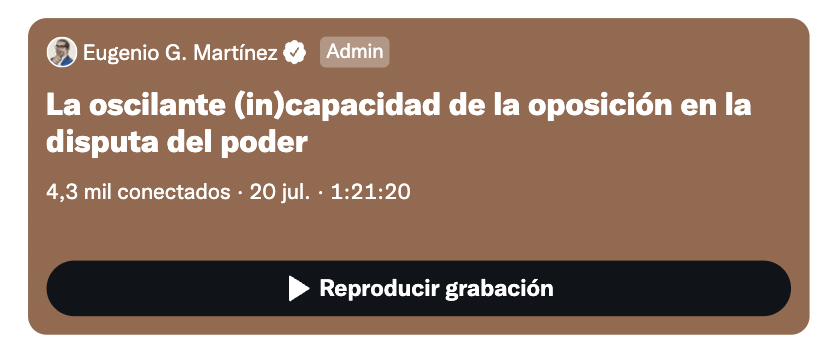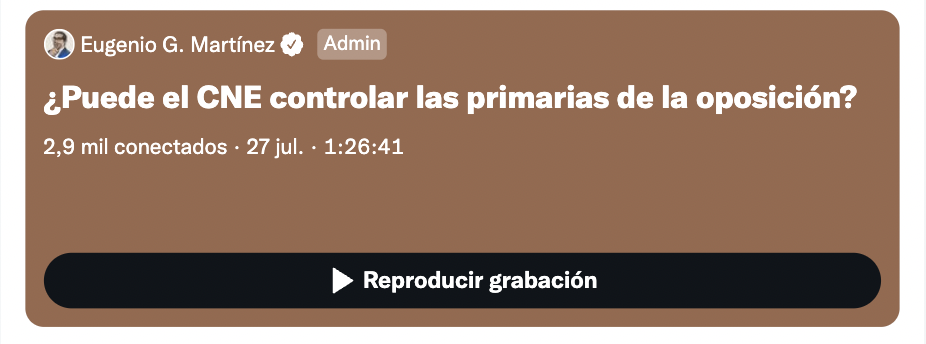A dispute emerged this week over the actual turn-out numbers in the July 30 election for a National Constituent Assembly, with the manufacturer of the voting machines disputing the number of voters reported by the National Electoral Council. Does it really matter how many people turned out in a vote boycotted by the opposition to elect a body considered illegitimate by the majority of Venezuelans and many foreign governments?
It matters for two important reasons.
First, if the numbers were inflated, it seriously undermines the electoral legitimacy relied on by chavismo since Hugo Chávez’s first election in 1998, and further discredits their argument to legitimate the national constituent assembly as a body representing the people. Foreign governments may take this into account as they weigh whether to recognize any decisions coming out of the constituent assembly – whether constitutional changes or legislative decisions.
Even while the exercise of power reduced freedoms and the rule of law over the years, the large electoral wins by Hugo Chávez in 2000, 2006, and 2012, and later by the opposition MUD in the 2015 legislative elections, were largely unquestioned in terms of the actual vote count and provided foreign governments with rationales not to criticize the growing concentration and abuse of power.
The electoral playing field became more and more unlevel and candidates were barred from competing without due process, but the electronic voting machines themselves were thoroughly tested and approved in a series of stringent audits including the participation of opposition party technical experts.
The absence of any independent monitors in the July 30, 2017 vote – either opposition monitors or national or international observer organizations – means that the extensive technical capacity to audit the vote still exists, but there have been no independent auditors to carry it out. This could still be remedied by carrying out audits now, as I will explain below.
The second reason it matters to understand what actually happened with this vote is that it will heavily influence the confidence of Venezuelans to participate in any future elections. Currently on the table are regional (gubernatorial) elections scheduled for December 2017, but with an August 8 deadline to nominate candidates.
Even while the opposition has been asking for an electoral timeline for the regional elections postponed from 2016, the municipal elections due in the 2017, and the presidential elections due in 2018, or early general elections, they now face a dilemma whether to participate in elections run by an election authority discredited by the manufacturer of the voting machines themselves for having reported made-up vote totals, for the first time since the machines were put in use in 2004.
Even if they decide to nominate candidates, will their voters come out to vote given extreme distrust of this electoral authority? A similar dilemma affected the opposition after they cried fraud in the 2004 recall referendum, and then urged their voters to come out and vote for regional and local candidates a few months later. Opposition candidates were trounced in those elections.
What can we determine about the actual vote results from July 30?
- The CNE has not yet, as of August 3, published results that they normally do within a few hours: total valid votes, total null votes, and results for candidates by voting table (mesa). This lack of information alone is disturbing, and makes it impossible to evaluate the varying numbers being bandied about.
- The voting machine manufacturer, Smartmatic, provides technical support for the machines, and provides technicians on election day at the election headquarters. They do not receive copies of the reports by machine or the total report, but they are on hand during the totalization unless they are removed by the election authorities. Smartmatic reports that the information they have enables them to estimate that the vote totals were inflated by at least one million votes. They assert that their machines could not be, and were not, tampered with. The implication of Smartmatic’s announcement is that the report given by Tibisay Lucena was “alternative facts”.
- Normally, political party technicians are in the pre-election and post-election audits. Party pollwatchers along with domestic observers are normally in the voting centers all day, and for the “hot audit” done in the evening where election officials count the paper ballot receipts each voter receives and deposits in an urn, and compares the results with the official electronic tally produced by each voting machine. Normally the parties get copies of the tally sheet from each machine, as well as the totalization report that comes from the transmission from each machine to election headquarters and then tabulated. None of this happened this time due to the boycott.
- Audits are still possible, and in fact one press article reported that the governing party’s electoral campaign strategist and former CNE head, Jorge Rodriguez, called for 100% audits of the machines to be carried out. If the CNE were actually to agree to such an audit, it could be done by counting the paper receipts for each machine with the electronic tally, and then adding up all of the machine totals to get a national total of voters.
A second audit that is normally done but was dropped by the CNE in their chronogram for this election is a post-election comparison of the fingerprints of voters nationwide, to determine if there were voters who voted more than once or had their identity stolen. This kind of audit is never 100% accurate and depends on how carefully one sets the parameters of the fingerprint matches, but it is used to determine whether voters or officials violate the law against multiple voting or usurpation of identity. This audit could still be done.
One of the political battles the government and opposition engage in is to demonstrate their superiority in strength of numbers of supporters (in votes as well as street protests) and thus the legitimacy of their mandates. Given that both the voting exercises on July 16 and July 30 lacked the normal electoral safeguards to prevent double voting and to provide auditable results, how are we to judge the claims and counter-claims about turn-out?
First would be for the CNE to report the actual total of valid and null votes, along with the detailed results by table. Then to carry out the post-election audits described above for the July 30 vote. Since the opposition did not use the CNE machinery, these audits are not possible for the July 16 consultation.
Second is circumstantial and anecdotal evidence. Public opinion polls before a vote asking how many voters are very likely or likely to vote give some indication. But in this case, there are also credible reports of coerced voting of government employees (about 3 million workers) and recipients of the discounted food bag in the CLAP system, such that it is difficult to estimate those who wanted to vote of the 20% approval rating for Maduro, and those additional who felt pressured to vote for fear of losing their job or benefits.
Photos of lines or non-lines provide anecdotal evidence, but it is difficult to estimate national totals without a systematic statistical sampling of polling centers, to gauge actual turn-outs.
Without more information from the CNE, we can estimate from the known information the following numbers. Datanalisis reported in July that 12.6% of voters were very likely to vote and another 12.5% somewhat likely to vote, giving a maximum projection of about 4.8 million voters. Some additional portion of the 3 million government employees or CLAP recipients may have felt pressured to vote. An exit poll analysis done for investment firm Torino Capital estimated 3.6 million voters. An exit poll relies on a statistical sample interviewing voters emerging from voting centers. Reuters reported 3.7 million voters by 5:20 pm, based on internal CNE documents, though the nature and method of the document is not described. The turn-out tracking system known as the SIE which allows the CNE to know how many voters have voted at any point during the day was reportedly not used in this election, according to a local NGO informally observing.
Smartmatic reports a million or more invented voters (i.e. not in the system), bringing the total down to about 6.8 million maximum votes recorded in the machines. Because voters were allowed to vote in any one of a number of centers, and the indelible ink was not used, it is very possible there could have been multiple voting. But it is impossible to know without the fingerprint audit how many such extra votes this might entail. It would require a huge organizational task to organize half a million voters to vote five times (and keep them quiet about it) to reach an extra 2.5 million votes to close to the pre-election polls or exit poll estimates (3.6 – 4.8 million) described above.
From the limited known information, we might reasonably conclude that somewhere between 4 million and 7 million people voted, either voluntarily or by coercion, on July 30. The government could have claimed some success, but instead chose opacity and alternative facts.
The real harm is to the Venezuelan public and their right to confidently exercise their vote in a voting process with integrity. The Venezuelan government destroyed in a single day a multi-year effort and millions of dollars devoted to building a voting system with multiple safeguards and the participation of all political parties to ensure transparency and accountability in the vote and vote count. Nevertheless, the integrity of the voting system can be restored with the implementation of all of the safeguards and audits normally used and the participation of political party technical experts and independent election observers.**
**Note, this analysis does not include the other real problems of the overall electoral process in Venezuela stemming from inequity in campaigns, disqualifying candidates, or the illegitimate origins and design of the constituent assembly election.
Jennifer McCoy is Distinguished University Professor of Political Science at Georgia State University
Credibility of Venezuela’s Electoral Process on the Line – Venezuelan Politics and Human Rights
A dispute emerged this week over the actual turn-out numbers in the July 30 election for a National Constituent Assembly, with the manufacturer of the voting machines disputing the number of voters reported by the National Electoral Council.





